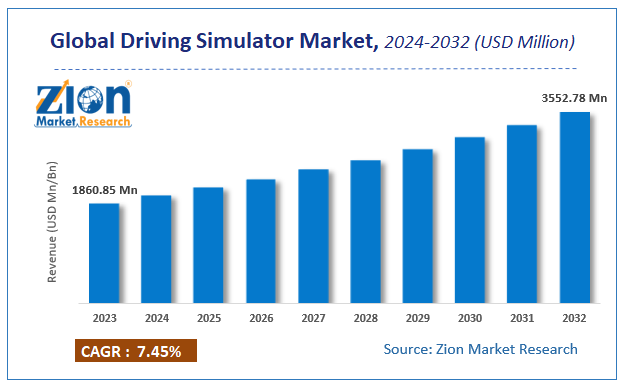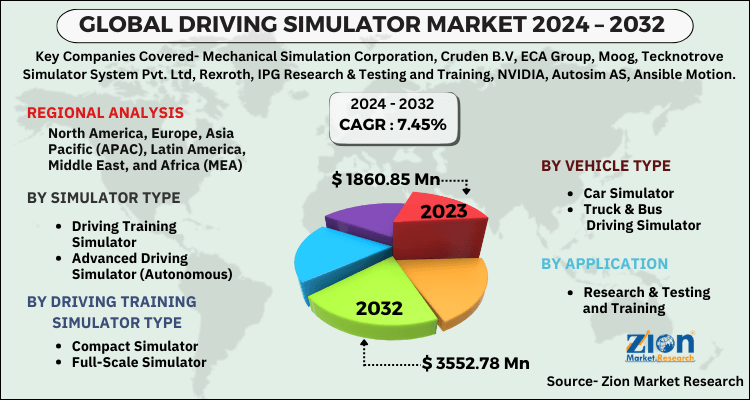Driving Simulator Market Size, Share, Growth, Forecast 2032

Driving Simulator Market By Simulator Type (Driving Training Simulator And Advanced Driving Simulator), By Driving Training Simulator Type (Compact Simulator And Full-Scale Simulator), By Vehicle Type (Car Simulator And Truck & Bus Driving Simulator), By Application (Research & Testing and Training) And By Region: Global Industry Perspective, Comprehensive Analysis And Forecast, 2023-2032
| Market Size in 2023 | Market Forecast in 2032 | CAGR (in %) | Base Year |
|---|---|---|---|
| USD 1860.85 Million | USD 3552.78 Million | 7.45% | 2023 |
The global driving simulator market size was evaluated at $1860.85 million in 2023 and is slated to hit $3552.78 million by the end of 2032 with a CAGR of nearly 7.45%? between 2023-2032.
The driving simulator market report is an indispensable guide on growth factors, challenges, restraints, and opportunities in the global market space. The driving simulator industry report covers the geographical market along with a comprehensive competitive landscape analysis. It also includes cash flow analysis, profit ratio analysis, market basket analysis, market attractiveness analysis, PESTEL analysis, SWOT analysis, Porter’s five force analysis, and value chain analysis. Additionally, the report explores the investor and stakeholder space to help companies make data-driven decisions.
Driving Simulator Market: Overview
The report studies the driving simulator market status and outlook of global and major regions. The research study includes historic data of the years 2016, 2017, and 2018 and forecast data from 2019 to 2025 based on revenue (USD Million). Evaluating the dynamics of the driving simulator market provides a brief reflection on drivers and limitations for the driving simulator market and its impact on demand in the next few years. The study also includes an analysis of global opportunities in the driving simulator market.
In addition, the report covers a comprehensive competitive scenario and portfolio of top suppliers in the driving simulator market. An analysis of Porter's Five Forces model for the driving simulator market has been included to understand the competitive landscape in the driving simulator market.
The study provides a crucial view on the driving simulator market by segmenting the market based on simulator type, driving training simulator type, vehicle type, application, and region. The segments are analyzed based on current and future trends, estimated from 2018 to 2025. The simulator type segment has been fragmented into driving training simulator and advanced driving simulator (Autonomous). On the basis of driving training simulator type, the market has been segregated into the compact simulator and full-scale simulator.
Global Driving Simulator Market Dynamics
The key market dynamics that are shaping the global driving simulator market include:
Key Market Drivers:
- Enhanced Safety and Cost Efficiency in Driver Training: Driving simulators provide a safe and cost-effective way to train new drivers and improve the skills of experienced ones. They replicate realistic driving scenarios such as dangerous conditions and emergencies without the dangers associated with on-road instruction. This capacity considerably lowers training expenses associated with car wear and tear, fuel consumption, and insurance fees.
- Developments in Virtual Reality (VR) and Simulation Technology: The advancement of virtual reality (VR) and simulation technology is fueling innovation in driving simulators. Modern simulators use high-fidelity graphics, motion platforms, and immersive VR headsets to create realistic driving situations. This realism improves the training experience by reproducing road conditions, traffic scenarios, and vehicle responses with remarkable precision.
- Rising Demand for Research and Development in the Automotive Industry: Driving simulators are used extensively in the automotive industry for research and development (R&D), particularly in vehicle design, testing, and validation. Simulators allow engineers and researchers to test vehicle performance handling characteristics, and safety features in a controlled setting before building prototypes.
Key Challenges:
- Cost of Implementation and Maintenance: One of the biggest issues with driving simulators is their high initial and ongoing costs. Building a high-fidelity simulator necessitates substantial investments in hardware, software, and infrastructure. This entails obtaining simulation software licenses procuring high-quality motion platforms, screens, or VR headsets, and integrating intricate control systems.
- Realism and Simulation Accuracy: Achieving realism and accuracy in simulation is critical for good driver training but it is a difficult task. Simulators must accurately represent real-world driving scenarios such as different road conditions, weather patterns, traffic circumstances, and vehicle dynamics.
- Training Transferability to Real-World Abilities: Another problem is ensuring that simulator abilities translate effectively to real-world driving. While simulators can simulate many driving circumstances, the experience of driving a vehicle on real roads entails nuances that may not be entirely captured in simulation.
Key Trends:
- Advancements in Virtual Reality (VR) and Augmented Reality (AR) Technology: Driving simulators are rapidly using virtual and augmented reality technologies to give more immersive and realistic training experiences. VR gives trainees the impression that they are in a real driving environment by using high-fidelity simulations of driving scenarios on head-mounted displays.
- Integration of Artificial Intelligence (AI) and Machine Learning (ML): AI and ML play an important role in improving driving simulators by enabling adaptive learning and scenario modification. AI systems monitor learner performance in real-time altering simulation factors such as traffic density, weather conditions, and road dangers to meet individual learning demands.
- Focus on Autonomous Vehicle Training: As autonomous vehicles become more prevalent driving simulators are increasingly being utilized to teach AI systems and test autonomous driving algorithms. Simulators offer a safe and controlled environment for validating and refining autonomous vehicle technology eliminating the dangers involved with real-world testing.
Moreover, the vehicle type segment covers car simulator and truck & bus driving simulator. The applications included in the market are research & testing and training.
Driving Simulator Market: Report Scope
| Report Attributes | Report Details |
|---|---|
| Report Name | Driving Simulator Market |
| Market Size in 2023 | USD 1860.85 Million |
| Market Forecast in 2032 | USD 3552.78 Million |
| Growth Rate | CAGR of 7.45% |
| Number of Pages | 138 |
| Key Companies Covered | Mechanical Simulation Corporation, Cruden B.V, ECA Group, Moog, Tecknotrove Simulator System Pvt. Ltd, Rexroth, IPG Research & Testing and Training, NVIDIA, Autosim AS, Ansible Motion, Dallara and CAE Value among others |
| Segments Covered | By Simulator Type, By Driving Training Simulator Type, By Vehicle Type, By Application and By Region |
| Regions Covered | North America, Europe, Asia Pacific (APAC), Latin America, Middle East, and Africa (MEA) |
| Base Year | 2023 |
| Historical Year | 2018 to 2022 |
| Forecast Year | 2024 - 2032 |
| Customization Scope | Avail customized purchase options to meet your exact research needs. Request For Customization |
Driving Simulator Market: Competitive Space
The competitive profiling of noticeable players of driving simulator market includes company and financial overview, business strategies adopted by them, their recent developments and product offered by them which can help in assessing competition in the market. Noticeable players included in the report are Mechanical Simulation Corporation, Cruden B.V, ECA Group, Moog, Tecknotrove Simulator System Pvt. Ltd, Rexroth, IPG Research & Testing and Training, NVIDIA, Autosim AS, Ansible Motion, Dallara and CAE Value among others. These players are undertaking strategic initiatives such as partnerships, distribution alliances, mergers, and acquisitions to consolidate their position in the market.
- Mechanical Simulation Corporation
- Cruden B.V
- ECA Group
- Moog
- Tecknotrove Simulator System Pvt. Ltd
- Rexroth
- IPG Research & Testing and Training
- NVIDIA
- Autosim AS
- Ansible Motion
- Dallara and CAE Value among others
Driving Simulator Market: Regional Insights
The regional module comprises the current and forecast demand for Middle East & Africa, North America, Asia Pacific, Latin America and Europe for driving simulator market with further bifurcation including U.S., Canada, Mexico, UK, France, Germany, Italy, Spain, China, Japan, India, Australia, South Korea, Brazil, Argentina, UAE, Saudi Arabia, and South Africa among others.
The report segment of the global driving simulator market as follows:
Global Driving Simulator Market: Simulator Type Segment Analysis
- Driving Training Simulator
- Advanced Driving Simulator (Autonomous)
Global Driving Simulator Market: Driving Training Simulator Type Segment Analysis
- Compact Simulator
- Full-Scale Simulator
Global Driving Simulator Market: Vehicle Type Segment Analysis
- Car Simulator
- Truck & Bus Driving Simulator
Global Driving Simulator Market: Application Segment Analysis
- Research & Testing and Training
Global Driving Simulator Market: Regional Segment Analysis
- North America
- The U.S.
- Europe
- UK
- France
- Germany
- Asia Pacific
- China
- Japan
- India
- Latin America
- Brazil
- Middle East and Africa
Table Of Content
Methodology
FrequentlyAsked Questions
A driving simulator is a specialized device or system that replicates the experience of driving a vehicle in a virtual or simulated environment. It provides users with a safe and controlled way to practice and experience various driving scenarios without the risks associated with real-world driving. Driving simulators are used for a wide range of purposes, including driver training, research, development and testing of automotive technologies, entertainment, and more.
The automotive industry's focus on vehicle safety, advanced driver assistance systems (ADAS), and autonomous driving technologies drives the demand for driving simulators. Simulators are used for testing, validating, and training these systems.
The global driving simulator market size was evaluated at $1860.85 million in 2023 and is slated to hit $3552.78 million by the end of 2032
with a CAGR of nearly 7.45%? between 2023-2032.
The regional module comprises the current and forecast demand for Middle East & Africa, North America, Asia Pacific, Latin America and Europe for driving simulator market with further bifurcation including U.S., Canada, Mexico, UK, France, Germany, Italy, Spain, China, Japan, India, Australia, South Korea, Brazil, Argentina, UAE, Saudi Arabia, and South Africa among others.
Noticeable players included in the report are Mechanical Simulation Corporation, Cruden B.V, ECA Group, Moog, Tecknotrove Simulator System Pvt. Ltd, Rexroth, IPG Research & Testing and Training, NVIDIA, Autosim AS, Ansible Motion, Dallara and CAE Value among others.
HappyClients
Zion Market Research
Tel: +1 (302) 444-0166
USA/Canada Toll Free No.+1 (855) 465-4651
3rd Floor,
Mrunal Paradise, Opp Maharaja Hotel,
Pimple Gurav, Pune 411061,
Maharashtra, India
Phone No +91 7768 006 007, +91 7768 006 008
US OFFICE NO +1 (302) 444-0166
US/CAN TOLL FREE +1 (855) 465-4651
Email: sales@zionmarketresearch.com
We have secured system to process your transaction.
Our support available to help you 24 hours a day, five days a week.
Monday - Friday: 9AM - 6PM
Saturday - Sunday: Closed








